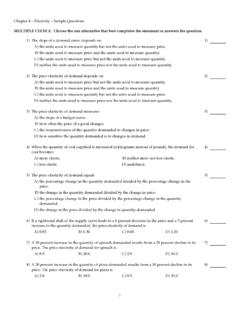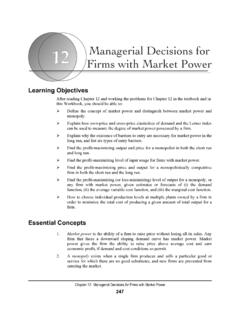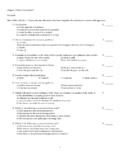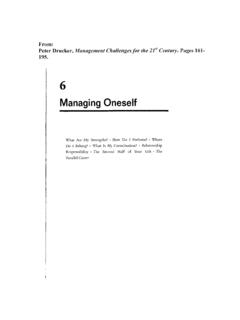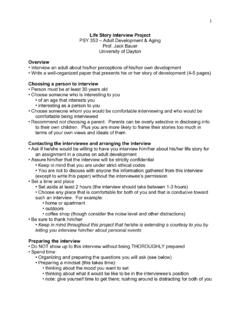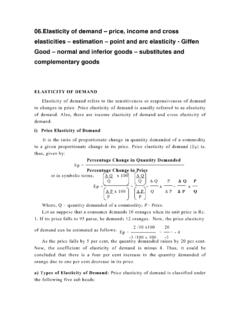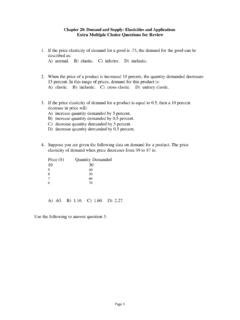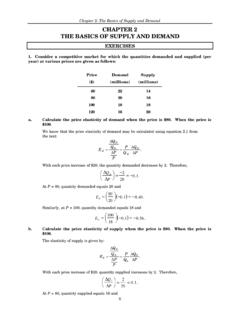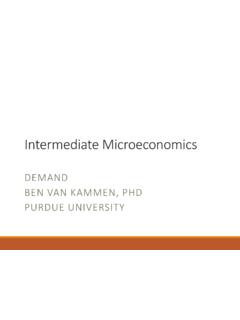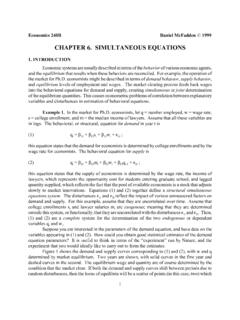Transcription of Chapter 12 Monopoly - Sample Questions MULTIPLE CHOICE ...
1 Chapter 12 Monopoly - Sample QuestionsMULTIPLE CHOICE . Choose the one alternative that best completes the statement or answers the ) Unregulated monopoliesA) cannot change the market ) can influence the market quantity and ) cannot ) take the market price as )2) The following are key features of a Monopoly EXCEPTA) diseconomies of ) no close ) influence over )barriers to )3) Which of the following statements about a Monopoly is FALSE?A) A Monopoly is the only supplier of the ) Monopolies have no barriers to entry or ) The good produced by a Monopoly has no close ) None of the above; that is, all of the above answers are true statements about a )4) Which of the following is LEAST likely to be a Monopoly ?A) the sole owner of an occupational licenseB) a pharmaceutical company with a patent on a drugC) a store in a large shopping mallD) the holder of a public franchise4)5) A public franchise isA) an exclusive right granted to an inventor of a ) a government issued license required to practice a ) a unique source of raw ) an exclusive right granted to a firm to supply a good or )6) Public franchises create monopolies by restrictingA) ) ) ) )7) A patent grantsA) a guarantee of quality to ) an exclusive right to an inventor of a ) the right to practice a ) control over a unique source or supply of raw )8) Patents create monopolies by restrictingA) ) ) ) )9) Patents are _____ barriers to entry and public franchises are _____ barriers to ) legal; legalB) legal; naturalC) natural; natural D) natural.
2 Legal9)110) A defining characteristic of a natural Monopoly is thatA) it exists because of legal barriers to ) it has no close ) its average total cost curve slopes downward as it intersects the demand ) its demand curve slopes )11) An industry in which one firm can supply the entire market at a lower price than two or morefirms can is called aA) legal ) single-price ) natural ) price-discriminating )12) Which of the following is true of a natural Monopoly ?A) The firm can supply the entire market at a lower cost than could two or more ) Its average total cost curve slopes upward as it intersects the demand ) The firm is not protected by any barrier to ) Economies of scale exist to only a very low level of )13) A market in which competition and entry are restricted by the granting of a public franchise,government license, patent, or copyright is called aA) price-discriminating ) single-price ) natural ) legal )14) A single-price Monopoly charges the same priceA) even if the demand curve ) to all ) even if its cost curves ) and the price equals the firm's marginal )15) All of the following are examples of price discrimination EXCEPTA) lower ticket prices for matinee )buy-one-get-one-free ) "early bird specials" at a ) "buy now, pay later" payment )16) Total revenue equalsA) total cost minus ) price times quantity ) marginal revenue times quantity )
3 The area between the demand curve and the marginal revenue )17) For a Monopoly , the industry demand curve is the firm'sA) profit ) marginal revenue ) supply ) demand )218) MonopolistsA) face downward sloping demand ) are price ) have no short-run fixed ) maximize revenue, not )19) The marginal revenue curve for a single-price monopolyA) lies below its demand ) is ) lies above its demand ) coincides with its demand )20) For a single-price Monopoly , marginal revenue is _____ when demand is elastic and is _____when demand is ) negative; positiveB) positive; positiveC) positive; negativeD) negative; negative20)21) If the price elasticity of demand is greater than 1, a Monopoly 'sA) marginal revenue is ) total revenue decreases when the firm lowers its ) marginal revenue is ) total revenue increases when the firm lowers its )22) If the price elasticity of demand is less than 1, a Monopoly 'sA) marginal revenue is ) total revenue decreases when the firm lowers its ) total revenue increases when the firm lowers its ) marginal revenue is )23) If the demand for its product is elastic, a Monopoly 'sA) total revenue is unchanged when the firm lowers its ) total revenue decreases when the firm lowers its ) marginal revenue is ) marginal revenue is )24) If the demand for its product is inelastic, a Monopoly 'sA) marginal revenue is ) total revenue is unchanged when the firm lowers its ) total revenue increases when the firm lowers its ) marginal revenue is equal to )25)
4 A Monopoly firm expands its output and lowers its price. The firm finds that its total revenue , the firm is producing in theA) inelastic range of its supply ) elastic range of its supply ) elastic range of its demand ) inelastic range of its demand )326) The figure above shows a Monopoly firm's demand curve. If the price and quantity of haircutsmove from point t to point r, the Monopoly 'sA) marginal revenue will ) total revenue will ) total revenue will remain the ) total revenue will )27) The figure above shows a Monopoly firm's demand curve. If the price and quantity of haircutsmove from point t to point u, the Monopoly 'sA) total revenue will remain the ) total revenue will ) marginal revenue will ) total revenue will )28) The figure above shows a Monopoly firm's demand curve. At point tA) demand is ) demand is ) demand is unit ) total revenue is at a )29) The figure above shows a Monopoly firm's demand curve.
5 The Monopoly 's total revenue is at itsmaximum when the firm produces at pointA) ) ) ) )30) The figure above shows a Monopoly firm's demand curve. The Monopoly 's total revenue is zero atpointA) ) ) ) )31) The figure above shows a Monopoly firm's demand curve. At point u in the figure, the demandfacing the Monopoly isA) less than the ) ) unit ) )432) An unregulated Monopoly willA) produce in the elastic range of its demand ) flood the market with goods to deter ) produce only where marginal revenue is ) produce in the inelastic range of its demand )33) An unregulated Monopoly finds that its marginal cost exceeds its marginal revenue. In order toincrease its profit, the firm willA) lower its price and increase its ) raise its price and increase its ) raise its price and decrease its ) continue to produce this level of output because any change will lower its )34) The figure above shows a Monopoly 's total revenue and total cost curves.
6 The Monopoly 'seconomic profit is positive if it produces betweenA) 0 and 20 ) 5 and 20 ) 0 and 15 ) 0 and 5 )35) The figure above shows a Monopoly 's total revenue and total cost curves. The Monopoly 'seconomic profit is zero if it producesA) 15 units of ) 5 or 20 units of ) 0 units of ) none of the above35)36) The figure above shows a Monopoly 's total revenue and total cost curves. The Monopoly 'seconomic profit is maximized when it producesA) 5 units of ) 20 units of ) 0 units of ) 15 units of )537) The figure above shows a Monopoly 's total revenue and total cost curves. The Monopoly 's marginalrevenue equals its marginal cost when it producesA) 5 units of ) 15 units of ) 20 units of ) 0 units of )38) The Monopoly with the TR and TC curves shown in the figure above will produceA) 5 units of ) 20 units of ) 15 units of ) 0 units of )39) For the unregulated, single-price Monopoly shown in the figure above, when its profit ismaximized, output will beA) 4 units per year and the price will be $ ) 6 units per year and the price will be $ ) 4 units per year and the price will be $ ) None of the above answers is )40) The unregulated, single-price Monopoly shown in the figure above will produce where its demandA) equals its ATC ) is ) is ) equals its )41) The unregulated, single-price Monopoly shown in the figure above has a total economic profit ofA) $ ) $ ) $ ) $ )642) The unregulated, single-price Monopoly shown in the figure above will sellA) 50 ) 30 ) less than 30 ) 100 )43)
7 An unregulated, single-price Monopoly is shown in the figure above. If fixed cost is $20, themonopoly's total costs when it is maximizing its profit will beA) $ ) $ ) $ ) $8043)44) An unregulated, single-price Monopoly is shown in the figure above. If fixed cost is $20, themonopoly's total economic profit when it is maximizing its profit will beA) $ ) $ ) ) $ )45) The Monopoly illustrated in the figure above is unregulated and charges a single price. Thedeadweight loss created by the Monopoly isA) $ ) $ ) $ ) $ )46) Unregulated monopolies can often earn an economic profit in the long run becauseA) they have high )barriers to entry prevent competing firms from entering the ) they receive government ) the risks of running a Monopoly are )47) Compared to a single-price Monopoly , a perfectly competitive industry producesA) more output and has a higher ) more output and has a lower ) less output and has a higher ) less output and has a lower )748) Which of the following statements is true?
8 A) A perfectly competitive industry produces more output and charges the same price as asingle-price ) A perfectly competitive industry produces less output but charges a lower price than asingle-price ) A perfectly competitive industry produces less output and charges the same price as asingle-price ) A perfectly competitive industry produces more output and charges a lower price than asingle-price )49) The fundamental reason a single-price Monopoly creates a deadweight loss is that itA) restricts ) raises variable ) raises fixed ) reduces the elasticity of )50) The unregulated, single-price monopolist illustrated in the figure above has a total revenue ofA) $ per ) $ per ) $ per ) $ per )51) The unregulated, single-price monopolist illustrated in the figure above has a total cost ofA) $ per ) $ per ) $ per ) $ per )52) The unregulated, single-price monopolist illustrated in the figure above earns an economic profitofA) $ per ) ) $ per ) $ per )53) The unregulated, single-price monopolist illustrated in the figure above will produceA) 6 units per ) 9 units per day.
9 C) 0 units per day. D) 4 units per )854) In the figure above, compared to a perfectly competitive industry with the same costs, asingle-price, unregulated Monopoly will decrease production byA) 2 units per ) 4 units per day. C) 6 units per day. D) )55) The unregulated, single-price monopolist illustrated in the figure above will set a price ofA) $ per ) $ per ) $ per unit. D) $ per )56) In the figure above, compared to a perfectly competitive industry with the same costs, asingle-price, unregulated Monopoly will raise the price byA) $ per ) $ per ) $ per ) $ per )57) In the figure above, the deadweight loss created if the industry changes from perfectly competitiveto a single-price, unregulated Monopoly isA) ) $ per ) $ per ) $ per )58) In the figure above, the redistribution from the consumers to the producer if the firm is asingle-price, unregulated Monopoly rather than a perfectly competitive industry isA) $ per ) $ per ) $ per ) )59) In the figure above, the single-price, unregulated Monopoly producesA) less than 20 units per ) 40 or more units per ) 20 units per )between 20 and 40 units per )60) If the industry in the above figure was perfectly competitive, the level of output wouldA) exceed the single-price Monopoly level of output by 20 )
10 Be less than the single-price Monopoly level of )be the same as the single-price Monopoly level of ) exceed the single-price Monopoly level of output by 60 )961) In the figure above, the efficient amount of output isA) 40 ) 60 ) 20 ) 80 )62) The output produced by the single-price, unregulated Monopoly in the above figure isA) efficient because marginal costs equals marginal ) efficient because profit is ) inefficient because too little is ) inefficient because too much is )63) In the figure above, the single-price, unregulated Monopoly sets a price ofA) $40 per ) $60 per ) $80 per ) $0 per )64) Consumer surplus isA) equal to the price minus the marginal ) less in the case of a single-price Monopoly than in the case of a perfectly competitive ) zero for a single-price ) positive in the case of a monopolist practicing perfect price )65) In comparison with a perfect competition, a single-price monopolist with the same costsA) generates a larger consumer surplus and a larger economic ) generates a smaller consumer surplus but a larger economic ) generates a larger consumer surplus and a smaller economic ) generates a smaller consumer surplus and a smaller economic )66) Compared to a competitive industry, a Monopoly transfersA) consumer surplus to ) producer surplus to ) deadweight loss away from producers to ) deadweight loss away from consumers to )67) Any attempt to capture a consumer surplus, a producer surplus, or an economic profit is calledA) efficiency ) ) ) price )68) Efforts by a firm to obtain a monopolyA) are called price ) are called price ) raise consumer ) are called rent )69) Activity aimed at creating artificial barriers to entry to a particular marketA) improves ) is rent ) has no social ) improves the economy's )70)
